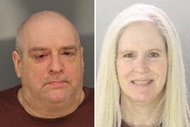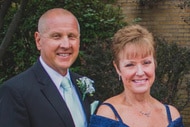Create a free profile to get unlimited access to exclusive videos, breaking news, sweepstakes, and more!
What Really Happened During The Deadly Raid At Black Panther Party Leader Fred Hampton's Home?
In a pre-dawn raid in December 1969, a team of law enforcement officials descended on the Chicago apartment of the Illinois chapter of the Black Panther Party's chairman and shot him dead.

In the early hours of Dec. 4, 1969, a group of law enforcement officers assembled by the Cook County state's attorney entered a ground floor apartment on Chicago’s West Side to execute a search warrant. They'd been tipped off that it was housing illegal guns. A barrage of bullets, somewhere between 90 and 100, was fired, and when the violent raid ended that morning, six people were injured, including two officers, and two key leaders of the Black Panther Party were dead.
The details about what actually happened that morning in the apartment of Fred Hampton, chairman of the Illinois chapter of the BPP, would play out in the city’s local media and its courtrooms over the following years. The killing of Hampton, who was 21 years old when he was shot dead in his bed, ignited the city in fresh political strife and marked a new wave of tension in the ongoing civil rights movement. The deadly raid and the events leading up to it are portrayed in the film “Judas And the Black Messiah,” which will be released Feb. 12 in theaters and on HBO Max.
Warning: spoilers for “Judas And the Black Messiah” below.
The raid, as was discovered two years later, was a part of the FBI’s COINTELPRO campaign — short for Counterintelligence Program — which was initially devised in the mid-1950s to surveil the Communist Party in the U.S., but was later expanded to infiltrate and disrupt other political groups the bureau deemed subversive. As “Judas And the Black Messiah” portrays, federal investigators recruited career criminal William O’Neal after a 1966 car theft arrest to infiltrate Chicago’s BPP, inform on their activities, and ultimately play a role in Hampton’s death. After the program’s discovery, the COINTELPRO campaign was criticized by Congress for abridging First Amendment rights — “rightfully" so, as the FBI now states on its website.
O’Neal posed as a BPP follower, and through December 1969 he quickly grew close to Hampton and his inner circle, notably as the dynamic Black Panther leader founded the Rainbow Coalition, a multicultural political collective that included some grassroots socialist and community groups in Chicago. Tension between the Chicago BPP and law enforcement ratcheted up over this period and turned violent and allegedly deadly, so police and the feds zeroed in on Hampton, who they deemed a radical threat. As was later revealed in a civil suit over the deaths in the raid, O’Neal had provided the FBI with the floor plans to Hampton’s apartment, which was a frequent BPP meeting place.
Mark Clark, the other young Chicago BPP leader to die that morning, was the first to see the law enforcement officials approach the apartment, as he was on security duty in the unit's front room, armed with a shotgun. The 22-year-old died instantly when he was shot in the chest by officers as they entered. His gun went off, striking the ceiling, in what was determined to have been the single shot fired by the BPP during the incident. Some have said that the shot was fired in a reflexive death convulsion.
Authorities, including Cook County state's attorney Edward Hanrahan, later said that the officers were under attack, and made photos available which they said "conclusively proved the Panthers opened the battle by firing a shotgun blast thru the apartment door,” as was reported at the time in the Chicago Tribune. Police even filmed what they called a reenactment of the raid, which was broadcast on a local news station. As conflicting details of the story exploded across headlines in the city’s papers, Hanrahan and the officers said they were not aware that Hampton and Clark would be in the apartment at the time.
After Clark was shot to death, the team of officers then began to fire at the other Black Panther Party members who had been sleeping in the apartment. The BPP had held a late-night meeting there and many members, though not O'Neal, who left around 1:30 a.m., had stayed to rest. As reported in the Tribune, officers described how they “fought it out with the Panthers in the darkened apartment which was found to be filled with shotguns, handguns, rifles," and an arsenal of ammunition. However, in the aftermath of the raid, the apartment was left unsecured by police, and reporters and members of the public were allowed in to survey the scene. In an article in the Sun-Times, it was reported that the alleged bullet holes in the kitchen door frame — seen in photos Hanrahan provided solely to the conservative Chicago Tribune, which reported them as the result of the Panthers firing at authorities — were actually broad nail heads.
Hampton was sleeping in his bedroom with his fiancée, Deborah Johnson, as this all unfolded. Johnson, who was then nine months pregnant, was removed from the room by officers after having protected Hampton from the barrage of bullets whizzing past by straddling his back. According to eyewitnesses, including Johnson, officers who entered the bedroom were heard saying that Hampton would survive his initial injuries. Then two gunshots went off in the room, and one officer said, “He’s good and dead now,” according to Johnson.
Since his killing, given the revelations about the illegal COINTELPRO program, many have deemed Hampton’s death an assassination.
There is also strong evidence that Hampton had been drugged ahead of the raid. According to Cook County officials, who performed a post-mortem analysis, a potentially lethal quantity of drugs was found in his bloodstream. This is consistent with the accounts of fellow BPP members who were in the apartment the night of the raid and said that Hampton had fallen asleep mid-sentence while on the phone. He was barely awake as shots were being fired, they said. Long after the raid, an associate of O’Neal said in a deposition that the informant told him he “had drugged Hampton the night of the assault,” as reported in The Nation. O’Neal denied this in a 1989 interview.
In total, four other BPP members — Verlina Brewer, Ronald "Doc" Satchel, Blair Anderson, and Brenda Harris — as well as two police officers were wounded in the raid. Seven BPP members were slapped with attempted murder, armed violence, and an array of weapons charges. By May, as the story of what happened moved from the newspapers and local TV to the courts, charges were dropped after ballistic tests and forensics torpedoed the state’s case.
The Justice Department, Cook County, and the city of Chicago did not settle the $47 million civil suit filed by Clark and Hampton’s families, or the $1.82 million suit by the raid’s survivors, until 1982. The settlement did not concede wrongdoing on the part of the government, a Justice Department attorney said at the time. But that was not the opinion of G. Flint Taylor, an attorney for the plaintiffs.
''The settlement is an admission of the conspiracy that existed between the FBI and Hanrahan's men to murder Fred Hampton,'' he said. ''The case may be almost over in the legal sense but it will live on as a reminder to people of how far the government can and will go to suppress those whose philosophies it does not like."



























